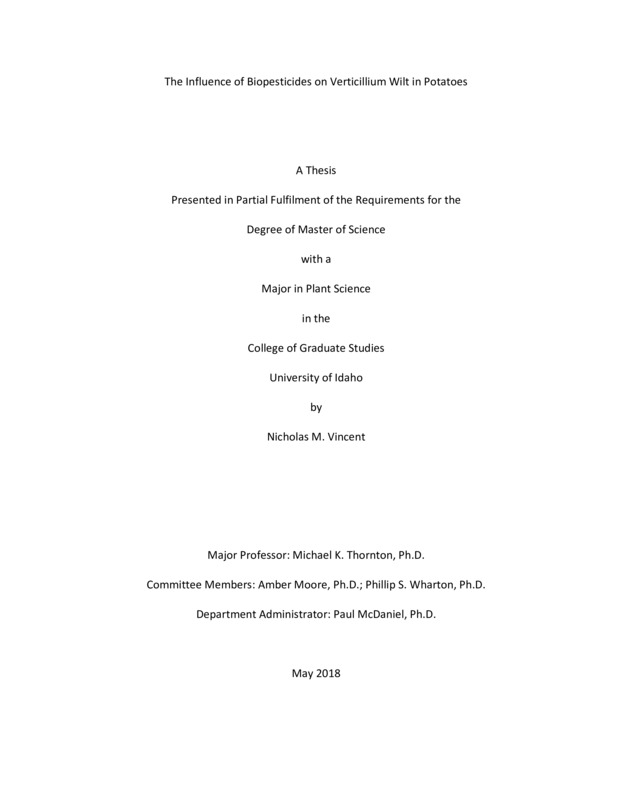The Influence of Biopesticides on Verticillium Wilt in Potatoes
Vincent, Nick. (2018-05). The Influence of Biopesticides on Verticillium Wilt in Potatoes. Theses and Dissertations Collection, University of Idaho Library Digital Collections. https://www.lib.uidaho.edu/digital/etd/items/vincent_idaho_0089n_11292.html
- Title:
- The Influence of Biopesticides on Verticillium Wilt in Potatoes
- Author:
- Vincent, Nick
- Date:
- 2018-05
- Program:
- Plant, Soil and Entomological Sciences
- Subject Category:
- Plant sciences
- Abstract:
-
Potato growers in Southern Idaho are searching for alternative ways to control diseases that are both environmentally sustainable and cost effective. The need for alternative approaches to chemical fumigants is critical, given the recent restrictions on chemical fumigants mandated by regulatory agencies. Application of biopesticides is an approach that is becoming more popular in the agricultural industry, but has not been evaluated extensively in potato production systems. A field and greenhouse experiment was conducted over a two-year period at the University of Idaho Parma Research and Extension Center in 2016/2017 to evaluate how these products might impact Verticillium wilt in potato. The field trial consisted of two biopesticide treatments (Bacillus subtilis and Trichoderma asperellum/Trichoderma gamsii) were applied at 4 different rates/timings. Bacillus subtilis rates consisted of 4.7 l/ha for in-furrow, 4.7 l/ha for low rate chemigation, and 9.4 l/ha for high rate chemigation. Trichoderma asperellum/Trichoderma gamsii rates consisted of 350.8 ml/ha for in-furrow, 2.8 kg/ha for low rate chemigation, and 5.6 kg/ha for high rate chemigation. The in-furrow treatment was applied at planting and the chemigation treatments were applied four times throughout the growing season. Soil and stem samples obtained from each of the treatments before the first chemigation and after all the treatments were completed were analyzed using a real-time polymerase chain reaction (qPCR) to measure the amount of Verticillium dahliae and Colletotrichum coccodes present in the soil and stem tissue. Symptoms of early die were rated at two week intervals and values were calculated using the relative area under the disease progress curve (RAUDPC). There were no significant treatment effects of Bacillus subtilis, Trichoderma asperellum/Trichoderma gamsii or fumigation with metam sodium on visual symptoms of early die, total tuber yield or pathogen populations in stem tissue or soil at harvest when compared with the non-treated control. The greenhouse study consisted of four biopesticides including Bacillus subtilis, Trichoderma asperellum/Trichoderma gamsii, Trichoderma virens, and Reynoutria sachalinensis plant extract. Field soil was amended with sphagnum peat moss to establish three levels of organic matter. There were no significant differences among the treatments that would suggest that biopesticides can effectively control Verticillium wilt in potatoes. More research is needed to understand the efficacy of these products on potato pathogens.
- Description:
- masters, M.S., Plant, Soil and Entomological Sciences -- University of Idaho - College of Graduate Studies, 2018-05
- Major Professor:
- Thornton, Michael K
- Committee:
- Moore, Amber; Wharton, Phillip S
- Defense Date:
- 2018-05
- Identifier:
- Vincent_idaho_0089N_11292
- Type:
- Text
- Format Original:
- Format:
- application/pdf
- Rights:
- In Copyright - Educational Use Permitted. For more information, please contact University of Idaho Library Special Collections and Archives Department at libspec@uidaho.edu.
- Standardized Rights:
- http://rightsstatements.org/vocab/InC-EDU/1.0/

